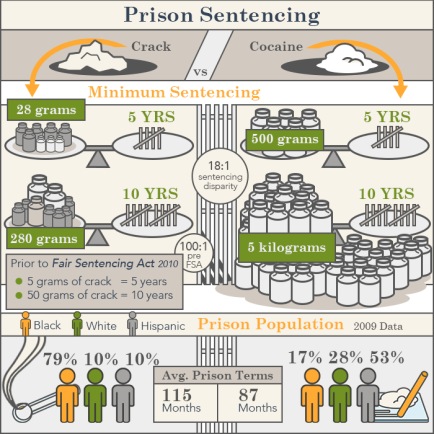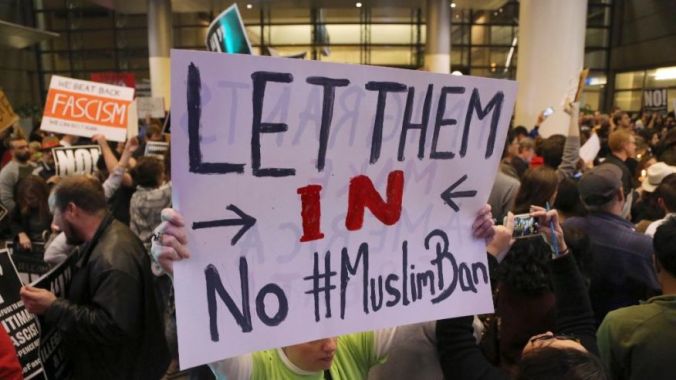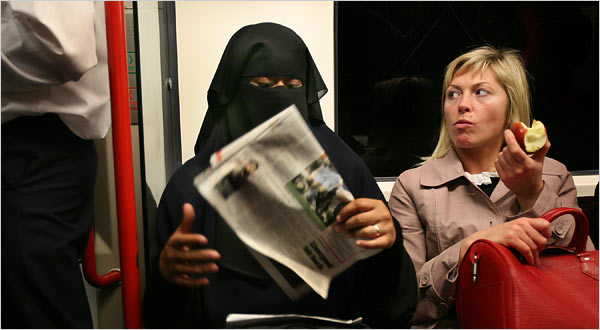In the 1980’s the inner cities of America experienced what many are taught as the “crack epidemic”. During this time – the nation responded with fear – not knowing what crack was – or that it was literally was cocaine but in a different form. Many stigma’s started to surround the use of crack cocaine, and as the epidemic got larger – the government responded with the ‘War on Drugs’. This has become a very controversial area of discussion. A lot of critics of the war on drugs believe that this government response was targeted towards minorities while the supporters claim it reduced crime. The “War on Drugs” was pushed under the Reagan Administration where many pieces of legislature were pushed through Congress to create zero-tolerance policies regarding drug usage/possession. The most controversial laws passed during this time was the mandatory sentencing laws in regards to crack-cocaine usage. If you were caught with 5 grams of crack cocaine – even if you were a non-violent, first-time offender, you were automatically given a mandatory minimum sentence of 5 years…compared to having 500 grams of cocaine which would trigger a 5 year sentence..

These new laws created a disparity in sentencing. Nonviolent drug law offenses increased from 50,000 in 1980 to 400,000 in 1997. Thousands of people were sent to jail – with mandatory minimum sentences of 5 years+ for having a small amount of crack cocaine although it turned out crack cocaine was the same drug as cocaine. 79% of 5,669 crack cocaine offenders in 2009 were African American. There was an obvious disparity in how the sentencing was directly impacting the African American population. Many people discussed the disparity and it became a very controversial topic since these laws where unfair compared to cocaine sentences which did not impact African Americans in the same sense – although they were technically the same drug.
This video discusses the impact of unfair sentencing laws: Drug Policy Alliance Video
Recently, these unfair sentencing laws were addressed by the same people who created them – Congress. In 2009, Senator Richard Durbin introduced the Fair Sentencing Act to Congress. The goal of this legislation was to reverse the unfair sentencing laws that affected thousands by reducing the disparity in sentencing from a 100:1 to 18:1 ratio and ended mandatory minimum sentencing in certain situations. This legislature was considered bipartisan and passed through Congress quickly and became law on August 3rd, 2010. Although this legislature, in my opinion was a move in the right direction, there was a gap in the law and confusion of who it applied to. There was a population of people who committed drug offenses prior to the Fair Sentencing Act but were not sentenced until after it’s passage. It was unsure if this legislation applied to their sentencing since it was not specified in the law itself. Due to this, the Supreme Court case Dorsey v. United States unfolded….
In 2008, Edward Dorsey was convicted on selling 5.5 grams of crack cocaine. As a prior offender, his minimum sentence under prior laws would be 10 years. Although the crime happened in 2008, Edward did not receive his sentence until after the passage of the Fair Sentencing Act in 2010. The judge on his case determined that since the crime happened prior to the passage of the Fair Sentencing Act that his sentencing would be determined by prior laws which meant he would get a minimum sentence of 10 years. Edward challenged this sentence which ultimately ended up in the Supreme Court.
The Supreme Court ruled in favor of Dorsey in a 5-4 decision. The majority court’s opinion was the intention of the Fair Sentencing Act was to restore fairness in sentencing and the only way to do this was to right-the-wrongs of past offenders. They believed this legislation applied to Pre-Act offenders which would change the sentences of thousands across America. If lower courts followed prior laws – they would continue to create disparities that Congress clearly intended to reduce and eventually end. Due to this, the court ruled in favor of Dorsey to make sure the disparities in sentencing would eventually end. Justice Antonin Scalia dissented followed by the other 3 justices writing that Congress did not imply that this law would specifically apply to offenders prior to the implementation of the new law and due to this – they wanted to follow standard protocal which states that the repeal of any statue does not imply that previous people affected by those laws will automatically get the benefits from a new law unless it is specified by Congress.
So what are the implications for social workers and why should we care?
Going back to the Fair Sentencing Act of 2010, under this new law, the ratio for sentencing comparing crack cocaine to cocaine went from 100:1 to 18:1 which means the disparity between the substances is NOT OVER. Thinking about how the substances are the same chemical – it is disturbing to think that crack cocaine still activates sentencing for having lower amounts compared to powder cocaine. It is a social justice issue, which is a core value in the social work profession. Crack cocaine offenders are more likely to be African American which means even though we made progress, these laws are still directly impacting the African American population. If we want to fulfill full equality, drug possession sentencing should be the same for crack cocaine and powder cocaine. This was a step in the right direction. Many people will have a chance to get re-sentenced and future generations will not face the same crucial penalties as they did in the past. It is important to recognize that there is still room for improvement and although we have advanced in our laws, social workers should still advocate on behalf of people affected by drug sentencing, in general. It is also important to note that this legislation was mainly directed towards the crack cocaine disparity. There are still many other laws implemented, that need to be revisited and probably rewritten to address the growing prison population in America.
Attached are additional information/resources regarding this topic:


